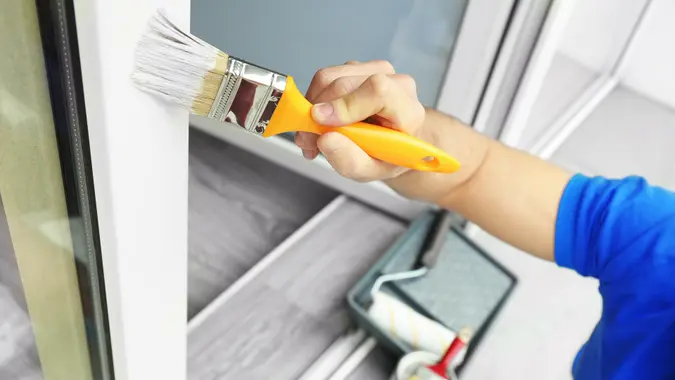Advertiser Disclosure
GOBankingRates works with many financial advertisers to showcase their products and services to our audiences. These brands compensate us to advertise their products in ads across our site. This compensation may impact how and where products appear on this site. We are not a comparison-tool and these offers do not represent all available deposit, investment, loan or credit products.
12 Items You Can Buy With Your FSA or HSA for Fall
 Written by
Addie Johnson Talbott
Written by
Addie Johnson Talbott
 Edited by
Jenna Klaverweiden
Edited by
Jenna Klaverweiden

Commitment to Our Readers
GOBankingRates' editorial team is committed to bringing you unbiased reviews and information. We use data-driven methodologies to evaluate financial products and services - our reviews and ratings are not influenced by advertisers. You can read more about our editorial guidelines and our products and services review methodology.

20 YearsHelping You Live Richer

Reviewed by Experts

Trusted by Millions of Readers
Pretty soon, the leaves will be turning bright colors and falling off the trees. If you have a flexible spending account (FSA) or health savings account (HSA), the dollars could also be falling out of your account at the end of the year — unless you use them up. It’s easy to forget that your FSA or HSA can cover plenty of everyday items and specialty services that will boost your well-being as the temperatures drop.
For 2024, the IRS has increased the contribution limit for FSAs by $150. FSAs are a great way to set aside up to $3,200 tax-free through payroll deductions and/or employer contributions. A couple can jointly contribute up to $6,400. Employers can choose to offer a maximum rollover of $640 in 2024, or they can offer a grace period of 2 1/2 months. But employers can’t do both (and they don’t have to offer either option).
For HSAs, individuals with a high-deductible insurance plan can contribute $4,150 this year. For family coverage, the limit is $8,300.
If you haven’t spent any of your FSA or HSA funds yet, it’s time to get going!
Don’t forget that you can use FSA or HSA funds for yourself or your spouse, any dependents you have, and any of your children who are under 27 by the end of the tax year. For a full list of covered expenses, see IRS Publication 502. But here are some items and services that are covered by FSAs and HSAs you may want to consider purchasing as we approach fall.
Eye Exams, Prescription Glasses and Contacts
Many health plans provide the bare minimum when it comes to eye care, so check your coverage and use FSA or HSA dollars to make up the difference on eye exams, glasses and contacts before the end of the year.
Having multiple pairs of glasses is never a bad idea, and don’t forget sunglasses! Eyecare supplies are covered too — so be sure to pick up contact lens solution and any eye drops you need for dry eyes, allergies or other conditions as the weather changes.
Dental Care
If you have extra funds, now is the time to schedule dental visits and any needed care for everyone in your family. Implants, sealants, wisdom tooth extraction, Invisalign? It’s all expensive, and it’s all covered in most cases.
Specialists Not Covered by Insurance
Do you need special or alternative care for medical conditions? Whether it’s a chiropractor, acupuncturist, nutritionist, massage therapist or nontraditional medicine practitioners, all can be covered with FSA or HSA funds.
However, for some of these services, you may need to provide documentation that they are medically necessary.
Prescriptions
Prescriptions are FSA and HSA eligible. Get 90-day supplies of everything you can in late summer or early fall. Put a reminder in your calendar at the end of November to check for any refills you may need so you can order them before the end of the year. That way, you’ll ensure you’re not leaving any FSA or HSA funds on the table.
First-Aid Supplies
With kids heading back to school in the fall, it’s a great time to check on your store of first-aid supplies and personal protective equipment, such as masks and hand sanitizer.
Replenish your first-aid kits at home and in your car. Stock up on any bandages and braces you may need for sports injuries, as well as heating and cold packs for aches and pains.
It also helps to be prepared for seasonal allergies and surges in infections of the flu and colds. And be sure to check expiration dates on old medications and replace them with new remedies.
Most first aid supplies are FSA and HSA eligible, so you can utilize those funds to purchase these fall must-haves.
Oura Ring
Devices that are used for monitoring your health are covered by an FSA or HSA. One example is the Oura Ring, which you can get in varying colors and sizes.
Oura Rings can be purchased with your FSA or HSA funds, but note that you should also check with your provider. “If you want to reimburse your Oura Ring purchase with FSA or HSA funds, you should always check with your FSA or HSA provider to ensure your purchase meets their requirements. Sometimes, your FSA or HSA provider will require a letter of medical necessity before approving a reimbursement request,” according to Oura’s website.
Therabody Products
Period Supplies
FSA or HSA funds can cover tampons, menstrual pads and period underwear. You’ll want to make sure that what you’re buying could realistically be used by the end of the year. If not, the IRS could decide it’s stockpiling and therefore not a covered expense.
Back-to-School Medical Expenses
If your child’s doctor recommends specialized care for a physical or learning disability, you can use your FSA or HSA to pay for it. Examples include occupational therapy and reading support for dyslexia. Though note in most cases, you’ll need a letter of medical necessity.
Home Access Improvements
Does someone in your family need an upgrade to their home in order to help them get around more easily? Everything from adding grab bars or ramps to grading the ground can be covered if the main purpose of the improvement is medical care.
“Home improvements, if primarily for a medical purpose, may be eligible for reimbursement with a Letter of Medical Necessity (LMN) with a flexible spending account,” according to Lively.
Mental Health Support and Addiction Treatment
FSA or HSA funds can be used for out-of-pocket expenses related to psychotherapy, as well as interventions and ongoing medical care for addictions.
Medical Travel
If you or someone in your household has a chronic illness, you can use FSA or HSA funds for transportation costs and fees associated with attending a medical conference. If you need to travel for medical care, you can use $50 per person per day to help with expenses.
More FSA and HSA Spending Tips
It can be hard to navigate the rules and requirements for your FSA or HSA funds, but there are things that can help.
Apps like Silver automatically scan your receipts for eligible items and submit the claims to your provider. Major retailers like Target, Walmart, Amazon and Costco all have FSA and HSA pages on their websites with products that are FSA and HSA eligible. Or you can visit websites like FSA Store, which sells only eligible products.
Don’t forget that the whole point of having an FSA or HSA is to save money by setting aside tax-free funds for your healthcare needs. If you find yourself with extra funds in your account at the end of the year, consider reducing your contribution for next year. Good luck, and use it up!
More From GOBankingRates
Share This Article:




You May Also Like

6 Christmas Items Retirees Should Consider Buying From Home Depot in 2025
November 19, 2025
7 min Read




4 Tech Devices Boomers Should Buy in Retirement -- Even If They Don't Think They Need Them
November 19, 2025
7 min Read






Best Ways To Save Your Money
Make your money work for you
Get the latest news on investing, money, and more with our free newsletter.
By subscribing, you agree to our Terms of Use and Privacy Policy. Unsubscribe at any time.


Thanks!
You're now subscribed to our newsletter.
Check your inbox for more details.



Sending you timely financial stories that you can bank on.
Sign up for our daily newsletter for the latest financial news and trending topics.
For our full Privacy Policy, click here.
Looks like you're using an adblocker
Please disable your adblocker to enjoy the optimal web experience and access the quality content you appreciate from GOBankingRates.
- AdBlock / uBlock / Brave
- Click the ad blocker extension icon to the right of the address bar
- Disable on this site
- Refresh the page
- Firefox / Edge / DuckDuckGo
- Click on the icon to the left of the address bar
- Disable Tracking Protection
- Refresh the page
- Ghostery
- Click the blue ghost icon to the right of the address bar
- Disable Ad-Blocking, Anti-Tracking, and Never-Consent
- Refresh the page







